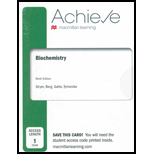
Concept explainers
(a)
Interpretation:
From the given twist number and writhe number, the linking number is to be calculated .
Concept introduction:
Circular DNA generally undergoes super coiling in order to fit itself inside a smaller space like a cell. Plasmids are the number of extra chromosomal material found inside bacterial cells. They are generally found in super coiled state.
(b)
Interpretation:
The writhe number is to be calculated based on the twist number and the linking number.
Concept introduction:
Circular DNA generally undergoes super coiling in order to fit itself inside a smaller space like a cell. Plasmids are the number of extra chromosomal material found inside bacterial cells. They are generally found in super coiled state.
Want to see the full answer?
Check out a sample textbook solution
Chapter 29 Solutions
BIOCHEMISTRY-ACHIEVE (1 TERM)
- Strictly no plagiarism.arrow_forwardYou have another circular plasmid. Complete and effective digestion of this plasmid with a restriction enzyme yields three bands: 4kb, 2kb, and 1 kb. In comparing the band intensity on an ethidium bromide-stained gel, you notice that the 4 kb and the 2 kb bands have the exact same brightness. The 1 kb band is exactly one fourth as bright as each of these. (Assume there is uniform staining with ethidium bromide throughout the gel.) How many times did the enzyme cut the plasmid? What is the size of the plasmid? Justify your answers to a and b above using a clearly labeled diagram showing the relative location of the cut-sites on the plasmid.arrow_forwardPretty sure I answered this wrong. Please helparrow_forward
- Need a good explanation.be quick.Thanksarrow_forwardExplain cohesively. Thank youarrow_forwardArial BIUA 11 + .. | I 1 I 3 I 4 i.) Fill in the table for each of the E. coli: (0) = No Activity (+) = Basal Activity and (+++) = High Activity E. coli chromosome F' Plasmid B-gal activity? Permease activity? When When When When Glucose is Lactose is Glucose is Lactose is present present present present a.) I+ P+ O+ Z+ Y+ Inone +++ +++ b.) I^[S] P+ O+ Z+ Y+ none c.) I+ P+ O^[c] Z+ Y+ none d.) I+ P+ O- Z- Y+ none e.) I+ P+ O+ Z+ Y+ I^[S] P+ O+ Z+ Y+ f.) I^[S] P+ O+ Z- Y+ I+ P+ O^[c] Z+ Y- g.) I^[TB] P+ O+ Z+ Y 1+ P+ O^[c] Z- Y+ h.) I+ P+ O^[c] Z+ Y- I+ P+ O+ Z** Y+ i.) I^[TB] P+ O^[c] Z+ Y- 1+ P+ O+ Z- Y+ Z** is a polar mutation ii. ) If the lac operon in 'a' carried a mutation in the CAP binding site that rendered it nonfunctional, how would that affect the level of ß-galactosidase protein activity with and without lactose present, why? MacBook Air 000arrow_forward
- please answer all. ill give thumbs uparrow_forwarddo explain.arrow_forwardDirection: Multiple choice. Choose a correct letter as correct answer. No need to explain the answer. Thank you in advance. Zoom in the pictures in order to see it clearly. It's just two problem so please provide an answer in no. 1 and 2.arrow_forward
 Human Heredity: Principles and Issues (MindTap Co...BiologyISBN:9781305251052Author:Michael CummingsPublisher:Cengage Learning
Human Heredity: Principles and Issues (MindTap Co...BiologyISBN:9781305251052Author:Michael CummingsPublisher:Cengage Learning
